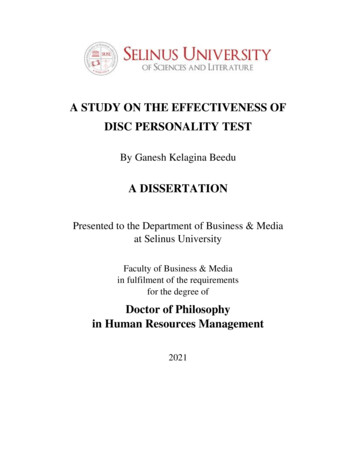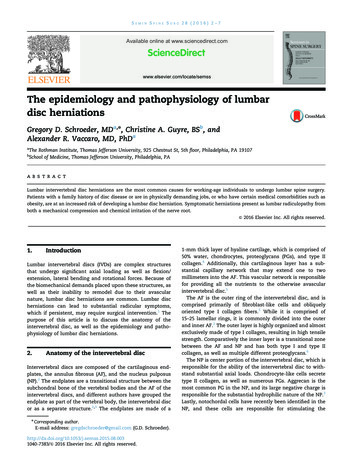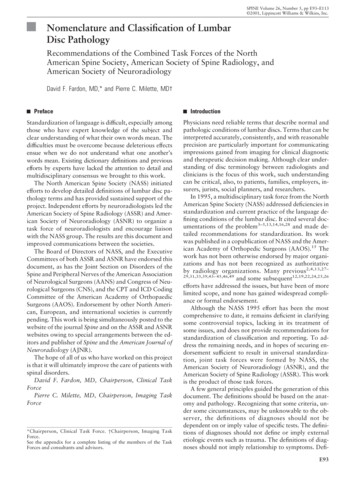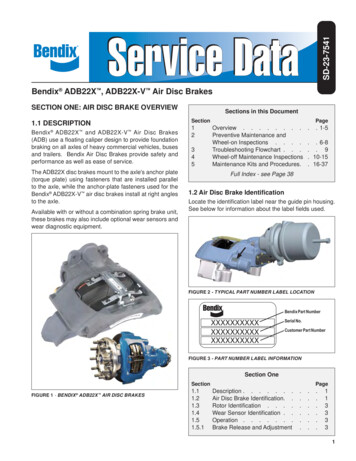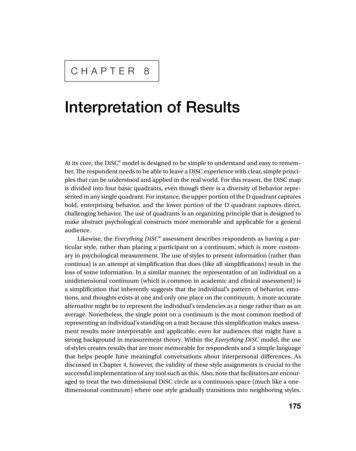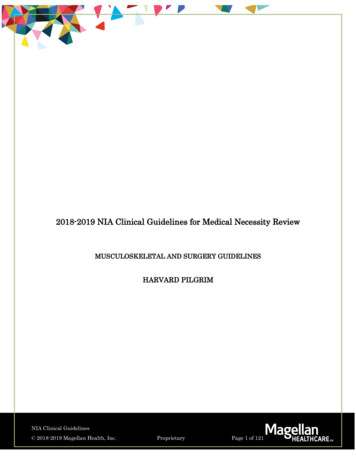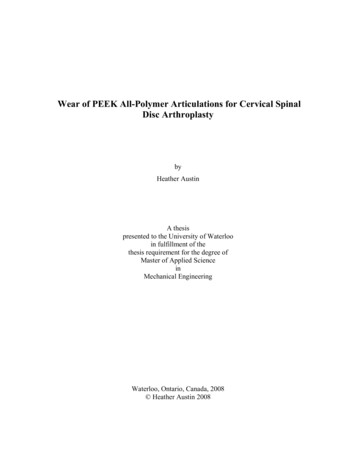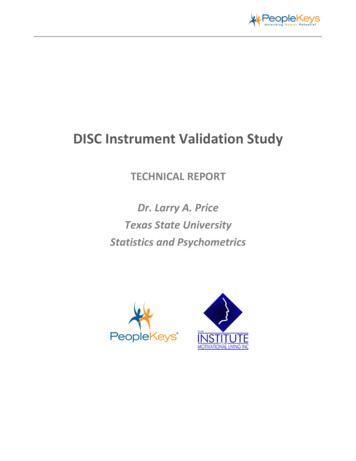
Transcription
DISC Instrument Validation StudyTECHNICAL REPORTDr. Larry A. PriceTexas State UniversityStatistics and Psychometrics
Table of ContentsSection 1Study OverviewSection 2Psychometric Development of the Institute for Motivational Living’s DISC InstrumentSection 3Sample Composition and DemographicsSection 4Evidence of Internal Structure: Score and Scale ReliabilitySection 5Evidence of Validity: Logical, Content, ConstructSection 6Special Problems Associated with Personality Assessment InventoriesSection 7Conclusions and recommendations for future studies 2015 All rights reserved. PeopleKeys Institute for Motivational Living Inc.
Section I: Study OverviewStudy OverviewThe purpose of this study was to examine the psychometric properties of the Institute for MotivationalLiving (IML) DISC Personality System Analysis survey instrument within the context of the workplaceenvironment. Ideally, the findings reported herein will serve to provide the IML with deeper understandingabout the psychometric properties of the DISC thereby enhancing the organization’s precision when using theDISC in the workplace environment.Personality is a vague construct that is often used to explain behavioral consistency within persons andbehavioral distinctiveness between persons. In fact, there are many definitions of personality in thepsychology literature with some focusing on particular aspects of an individual (Goldstein, 1963a) while othersview the individual within the context of society or particular social setting (Sullivan, 1953). Historicallypersonality assessment has focused on the measurement of interpersonal emotions, attitudes, and personalitystyles and /or motivational attributes rather than cognitive abilities such as intelligence or achievement. Theearliest personality theory attempted to sort individuals into discrete categories or types. For example, theearly Greek physician Hippocrates proposed a humoral theory with four personality types (sanguine, choleric,melancholic, and phlegmatic). In consideration of the historical research contributions pertaining to thenotion of personality (e.g., Traits, Types, and States) and personality assessment, a contemporary definitionthat is offered by Cohen & Swerdlik (2005) and is a flexible yet parsimonious definition of personality - “anindividual’s unique constellation of psychological traits and states” (p. 336). Further, Cohen & Swerdlik (2005)define personality assessment as “the measurement and evaluation of psychological traits, states, values,interests,, attitudes, worldview, acculturation, personal identity, sense of humor, cognitive behavior styles,and/or related individual characteristics” (p. 336). Cohen and Swerdlik’s definition of personality merges withprevious research to offer the notion that personality is multidimensional in nature. With thismultidimensional definition in mind, this study will use both classical psychometric analytic methods as well asnewer approaches that are well-suited for the study of multidimensional constructs.About the Institute for Motivational Living PeopleKeys The Institute for Motivational Living PeopleKeys DISC Insights Personality System Analysis is classifiedas a self-report inventory and is administered either in a paper-pencil or computer aided format. The Institutefor Motivational Living is a training and publishing company designed to help people communicate better andwork together more effectively. "The Institute" trains and certifies individuals in product usage with theirbehavior analysis course, Introduction to Behavioral Analysis. This training course provides the expertise toconsultants, entrepreneurs, business managers, pastors and counselors in the use of the DISC PersonalitySystem and other behavioral assessment profiles for use in team building, career planning, hiring, conflictresolutions, family counseling, personal counseling, marriage counseling and executive coaching. TheInstitute’s online PeopleKeys system, designed for administering DISC in the workplace, was used within thisstudy to collect data as a part of the research. 2015 All rights reserved. PeopleKeys Institute for Motivational Living Inc.Page 1
Section II: Psychometric Development of the Institute for Motivational Living’s DISC InstrumentSteps in item development in relation to logical and content validityThe process of determining and deriving the operational definitions of the item content was basedprimarily on the original theoretical work of William Marston, M. D. as published in Emotions of Normal People(1928). Based on Marston’s theory, the items on the IML DISC were developed to tap four latent dimensions ofpersonality as espoused by Marston. Additionally, item content and wording was refined through an iterativeprocedure so as to allow for the maximum potential for actually tapping a particular latent construct ordimension. Item quantity (e.g., the number of items comprising the scale) and content redundancy areimportant issues to be considered during the development for reasons of ensuring an adequate level of scalereliability and validity. In order to ensure that the latent construct is being measured in a variety of ways, theinstrument development team balanced the number of items on the final scale as well as the amount anddegree of redundancy the items exhibited. Although some of the items on the DISC appear to be redundant,the inclusion of the items was deliberate and based on content experts at IML in order to assure adequateassessment of the latent dimensions or constructs according to Marston’s theoretical framework. In summary,during the item development and refinement process, the IML development team displayed evidence ofadhering to the Standards for Educational and Psychological Testing published by the American EducationalResearch Association (AERA), American Psychological Association (APA), and the National Council onMeasurement in Education (NCME, 1999).Brief Review of Research of the Forced-Choice Item FormatThe forced-choice rating technique is used on the IML DISC where the subject responds to four sets ofwords or phrases and is required to select one of the four sets that MOST describes his/her behavior in thework environment and one of the four sets that LEAST describes his/her behavior in the work environment.Highland & Berkshire (1951) conducted an extensive study of forced-choice rating forms in connection withrating instructors. Highland-Berkshire investigated six different configurations of forced-choice item formats inan effort to determine which format yielded the highest level of internal consistency reliability; validity againsta criterion of rank ordering of the instructors; susceptibility of the scores to biasing (with raters told to assureratees with high scores); and popularity of the rating form from the point of view of the raters. Highland &Berkshire’s findings include the following points:1)The highest reliability coefficients were attained when the item formats were composed of four wordsor statements, two being favorable and two unfavorable; the rater selecting the most and the leastdescriptive. This finding regarding item format provides psychometric support for the approach used inthe IML DISC.2)The highest criterion validity evidence was observed when the item formats were composed of fourwords or statements, all being favorable; the rater selecting the most descriptive and the leastdescriptive. This finding regarding item format provides psychometric support for the approach used inthe IML DISC.3)Finally, the item formats that were composed of four words or statements, all being favorable; therater selecting the most descriptive and the least descriptive revealed the smallest evidence ofresponse bias. Overall, this item format, the same as used in the IML DISC instrument, was regarded asdisplaying “optimum” psychometric characteristics. 2015 All rights reserved. PeopleKeys Institute for Motivational Living Inc.Page 2
Important Considerations for the Development and use of Forced-Choice Ipsative ScalesCriticisms of the forced-choice item based instrument include a substantial amount of time and energyto construct this type of scale, and that fact that this type of scale is constructed in a way so as to displayevidence of construct validity for a particular population or group of interest. In consideration of this issue, thesample was purposefully selected to represent personality style in the workplace environment. A second issuethat is important for developers and users of the forced-choice type of scale is the fact that the type ofmeasurement is “ipsative”, meaning that the subject’s responses and the presumed strength of a measuredtrait are interpreted relative to the measured strength of other traits of that same subject, or alternatively, themeasurement is “within a person”. Users of this type of scale must always be mindful of the underlyingtheoretical nature of the ipsative measurement and scoring approach so as to use the scores or classificationinformation in an appropriate manner. 2015 All rights reserved. PeopleKeys Institute for Motivational Living Inc.Page 3
Section III: Sample Composition and DemographicsThis primary goal of this study was to investigate the psychometric aspects of the IML DISC within thecontext of the workplace environment. Therefore, a purposive sampling strategy was employed for datacollection process. Respondents were employed in the social service and counseling field, and ranged in jobposition from entry level administrative to National Executive Director.The sample obtained was cross-sectional representing seven different regions of the country in 26separate locations. Specifically, represented in the sample are the northeast, Midwest, South, and Southwestregions of the United States. The ethnic composition of the sample was 76% Caucasian, 12% African-American,11% Hispanic, and 1% Other (Asian/Pacific Rim). Eighty-seven percent (87%) of the subjects were female, 13%male with an age range of between 21 – 85 years. All of the subjects had attained a minimum of 12 years offormal education with most having 16 years. Three hundred thirty one (331) survey instruments werecompleted and returned for analysis. 2015 All rights reserved. PeopleKeys Institute for Motivational Living Inc.Page 4
Section IV: Evidence of Internal Structure – Score and Scale ReliabilityWithin the context of psychological measurement the term “reliability” broadly refers to the accuracy,consistency, and stability of scores obtained on a measurement instrument. This consistency, accuracy, orstability does not represent a qualitative description of how “good” or “bad” the scores obtained by the scaleor instrument are in terms of the construct that it purports to measure, rather only the degree to which thescale produces consistent and/or stable scores. An important aspect also related to the estimation of reliabilityis known as “measurement error”. Plainly stated, no psychological scale or instrument produces “error free”measurement. Therefore, according to classical true score theory (Allen & Yen, 1979; Nunnally & Bernstein,1978), score reliability estimates are represented by two components: 1) the examinee’s true score on theunderlying psychological construct; 2) errors of measurement that have nothing to do with measuring theexaminee’s underlying trait. The error or errors of measurement is/are mathematically related to the reliabilitycoefficient and represent the inaccuracy of measurement on a particular testing occasion or over time as in atest-retest situation.The methods of estimation of score reliability in the present study are based on classical measurementtheory also know as the classical true score model (Allen & Yen, 1979; Nunnally & Bernstein, 1978). There areseveral procedures for estimating the reliability of scores within the context of the classical true score model.These include internal consistency, stability, alternate forms, parallel forms, inter-scorer/interrater agreement,and decision consistency. The decision regarding which method of reliability estimation to use is primarilydriven by the nature of the scale or instrument under investigation and the specific purpose for which theinstrument is being used. In the present study, evidence of reliability is presented based on indices of internalstructure and decision consistency. Finally, a rigorous structural equation modeling approach was used toexamine the congruence between the estimated reliability of the IML DISC subscales and its construct validity.Evidence of Internal ConsistencyInternal consistency estimates of reliability represent the homogeneity of items that comprise theinstrument or scale. Ideally, the individual items on a scale will be moderately to highly correlated amongthemselves thereby lending support to the notion that the items are likely tapping the same underlyingpsychological construct or share the same cause. Although the underlying construct is unobservable or “latent”and therefore not directly measurable, the items are measurable and subsequently the intercorrelationsamong them can be assessed. Within the context of the present study, the underlying factor structure of theDISC is theoretically represented by four factors or latent constructs first proposed by Marston (1928). Thesefour factors (e.g., dimensions) are: 1) Dominance, 2) Influence, 3) Steadiness (submission originally), and 4)Compliance. Therefore, the latent factor structure underlying the 24-item DISC instrument is multidimensionalconsisting of certain items within the total twenty-four that reflect a particular piece of the multidimensionalstructure of the DISC theory.Given the multidimensional nature of the IML DISC, internal consistency estimates of reliability andassociated standard errors of measurement are reported for each factor or dimension and also for the twentyfour item scale. Table 1 below provides the intercorrelations among each of the DISC subscales. Table 2.provides the estimates of internal consistency reliability (coefficient alpha) and associated standard errors ofmeasurement derived from a random subsample of 200 subjects from the total sample ( N 331).Inspection of correlation coefficients allows one to compare the strength and direction of associationsbetween different pairs of variables. The results provided in Table 1. illustrate that the patterns of associationsamong the four subscales covary in magnitude and direction as expected according to Marston’s original 2015 All rights reserved. PeopleKeys Institute for Motivational Living Inc.Page 5
theory. Interpretation of the practical effect of a correlation coefficient include the following guidelines: 1)coefficients below .35 (in absolute value) are considered as reflecting a “low” degree of association; 2)coefficients between .36 and .65 (in absolute value) are considered as reflecting a “moderate” degree ofassociation; 3) coefficients above .65 (in absolute value) are considered as reflecting a “high” degree ofassociation. Finally, whether the coefficient is proceeded by a “ ” or “-“ sign, dictates whether the observedrelationship between the two variables increases in a positive manner (e.g., as a value on one variableincreases, so does the value on the other variable being examined), or is “inverse” (e.g., as a value on onevariable increases, the value on the other variable being examined decreases).With the aforementioned guidelines in mind, if the dominance dimension is considered as the “baseline”dimension, then the following descriptions are offered based on the results observed herein:1)2)3)Dominance exhibits a “low, positive” relationship with the Influence dimension indicating intensityof extroversion.Dominance exhibits a “moderate, negative” relationship with the Compliance dimension in termsof task-oriented style.Dominance exhibits a “strong, negative” relationship with the Steadiness dimension indicatingintensity of extroversion.Table 1. Spearman correlation coefficients for four DISC subscales (N 331)Subscale12341. Dominance-2. Influence.10-3. Steadiness-.80**-.29**-4. Compliance-.35**-.69**.23**-Note. Spearman correlation coefficients are derived based on standard scoringprocedure.**Significant at p .01Table 2. Subscale Reliability (N eadiness.734.00Compliance.841.89Overall.877.39r coefficient alpha, SEM standard error of measurementNote. Sample is composed of 200 subjects randomly selected from thetotal (N 331) sample. 2015 All rights reserved. PeopleKeys Institute for Motivational Living Inc.Page 6
Evidence of Agreement between DISC Theory and ChanceAnother form of reliability evidence presented herein is percent agreement between the responsesobtained from the examinees and the classification of personality style according to the underlying DISCtheory. The percent agreement between the examinee’s responses within a “primary” style or a closesecondary “primary” style according to DISC theoretical expectations was high (91%). In order to furtherexamine the proportion of agreement between DISC theory and the observed examinee responses, theMcNemar nonparametric test for two related (matched) dichotomous outcome variables was used.McNemar’s test is particularly useful in detecting changes in patterns of examinee responses in "before-andafter" or “related subjects” designs. The results of the McNemar were observed to be statistically significant atthe p .05 level of significance. Interpretation of this finding reveals that the percent agreement was not only“good”, but may also be stated to be “statistically significantly”. Finally, the Kappa coefficient, an agreementstatistic that statistically adjusts for capitalization due to chance was also calculated. In this study, coefficientKappa was observed as r .40. This level of congruence between the theory and actual observed responses isclassified as “good” agreement beyond the level of chance (Landis & Koch, 1977a). 2015 All rights reserved. PeopleKeys Institute for Motivational Living Inc.Page 7
Section V: Evidence of ValidityEstablishing evidence for the validity of a particular psychological or educational instrument, scale ortest is likely to be the most important aspect of instrument development. According to the AmericanPsychological Association, the American Educational Research Association, and the National Council onMeasurement in Education (1999), the term “validity refers to the degree to which evidence and theorysupport the interpretations of test scores entailed by proposed uses of tests”, (p. 9). Moreover, inpsychological measurement and assessment, the term “validity” represents a judgment or expression of howwell an instrument or test measures what it purports to measure. It is a judgment based on evidence about theappropriateness of inferences draw from test scores. Therefore, validation, involves the process of developinga sound, scientifically-based argument that will support the intended use of the scores or classificationsderived from using the instrument. The process of test or instrument validation involves conductinginvestigations and accumulating evidence to provide a sound framework for the proposed score orclassification interpretations. The score interpretations are theoretically linked to the theoreticalunderpinnings or construct that the instrument purports to be measuring. In the present study, the theoreticalframework that the IML DISC instrument incorporates was first proposed by William Marston in his text“Emotions of Normal People” published in 1928. Within the context of the present study, the underlying factorstructure of the DISC is theoretically represented by four factors or latent constructs first proposed by WilliamMarston (1928). These four factors (dimensions) are: 1) Dominance, 2) Influence, 3) Steadiness (submissionoriginally), and 4) Compliance. Therefore, the latent factor structure underlying the DISC instrument ismultidimensional and consists of certain items within the total twenty-four items that reflect a particular pieceof the multidimensional structure of the DISC theory.Finally, the validity of an intended interpretation of test scores or classification outcomes reliescollectively on adequate score reliability, appropriate test administration, accurate scoring and scaling, andcultural fairness to examinees.Evidence Based on Instrument Item Content – Content ValidityContent validity evidence refers specifically to themes, wording with current cultural issues in mind,item formats, tasks, and guidelines for administration and scoring. In the present study, evidence forappropriate content validity was established by qualified experts at the Institute for Motivational Living bycompiling a series of statements and traits that are universally accepted as the basis for the four DISC styles.This exercise was based on Marston’s original theoretical work and descriptors as published in Emotions ofNormal People (1928). Furthermore, the composition of the descriptors and statements for the four styles wasalso compared with other leading DISC publications of modern times to establish universal evidence ofagreement for the “core” observable behaviors or traits. This exercise also served to establish evidence of“face” or “logical” validity for the IML DISC instrument.To extend the content validation process, a group of 12 certified behavior analysts were asked to ratethemselves using this survey instrument as well as have their colleague review their choices to ensurecongruence between how the analysts rated themselves using the DISC related to how others observed theirbehavior. Finally, since this validation study was conducted within the context of a workplace setting orenvironment, the Bair Foundation National Office began the study by taking 25 people from the NationalOffice and had them take the 24 item DISC. This step served as baseline or pilot information for the study aswell as provided an orientation to the instrument to the Bair Foundation who provided access to the overallsample. 2015 All rights reserved. PeopleKeys Institute for Motivational Living Inc.Page 8
Evidence Based on Internal Structure – Construct ValidityThe primary purpose for investigating the internal structure of an instrument is to gain evidence thatthe relationships among items conform to the theoretical construct on which proposed test scoreinterpretations are based. As previously discussed, the underlying structure of the DISC is multidimensional innature and is composed of four subscales each representing a separate but correlated dimension ofpersonality style. Therefore, an important goal of the present study was to rigorously investigate the factorstructure of the IML DISC instrument in relation to Martson’s theoretical framework using two specific types offactor analytic approaches: 1) the Q – Technique, and 2) the R – Technique within a structural equationmodeling framework.The Q – Technique factor analysis method is particularly appropriate for the study of classifyingindividuals based on preferences or systems of typology – such as in personality assessment. Typically, Q –technique studies employ a small number of subjects because the issue of interest is the notion of “intraindividual differences” (within subjects) rather than “inter-individual” (between subjects) differences. Theinherent nature of the forced-choice measurement approach make traditional factor analytic techniques (R –technique) often inappropriate due to the “correlated” nature of the item formats and also because of thedistributional shapes of the data obtained from respondents. The Q – Technique analyses proceeded asfollows. First, ten separate random samples of size 20 were selected for analysis using Q – Technique factoranalyses. Next, each random sample was factor analyzed using both Principle Components Analysis (PCA) withVarimax rotation and then using Principle Axis Factor Analysis (PAF) with Promax Oblique rotation. In all 10analyses, the results provided evidence of a four factor dimensional structure underlying the IML DISCinstrument. Across all analyses, an average of 70% of the total variance was explained by the four factor DISCmodel. As a general rule, the guideline for the percentage of variance accounted for in a factor analytic modelto be evaluated as “acceptable” in the psychometric literature is 70%.The inherent nature of the forced-choice measurement approach make traditional factor analytictechniques (R – technique) inappropriate due to the “correlated” nature of the item formats and also becauseof mathematical scaling problems. To account for this artifact, a modified scaling approach to the items wasemployed by the author thereby allowing for the exploratory (preliminary) investigation of the theoreticalfactor structure using structural equation modeling. A detail examination of the factor loadings and dimensioncorrelation coefficients is instructive. Specifically of interest is how several items load on more than a singleitem, indicating clear evidence of item overlap and multidimensionality of the scale. Since the IML DISC (or anyDISC) instrument has not previously been examined in this way, this is new information regarding theconstruct validity evidence of this scale. 2015 All rights reserved. PeopleKeys Institute for Motivational Living Inc.Page 9
Figure 1. The IML DISC multidimensional four-factor oblique structural equation model.50e1Q 22.07e2Q 02.70.08.26Q 14.28e3.01.09Dom inance-.01-.06e4Q 18.02e5Q 05.00Q 16.36e6.01-.14e7Q 04.01.10.64.80Influencee8Q 07.07e9Q 11.20.06.06.04Q 03e10.00Q 19e11.03Q 20.63e12.00-.38.18-.58e13Q 23.00.01e14Q 13.03Steadiness.12.05.23e15Q 12.18.83-.17.08-.02.03e16Q 01.41e17Q 17.01e18Q 21.35.00e19Q 08.15e20Q 06.39Com pliance.02.13.30e21Q 15.42.18e22Q 24.11.04Q 09e23.00Q 10e24Figure 1 Notes. Numbers of the one-way arrows moving from the ovals (latent constructs) to therectangles (items on the DISC) are standardized regression weights (correlation coefficients). Numbers on thecurved two-headed arrows are correlation coefficients between latent constructs. Numbers at the upper rightcorner of each item represent the squared multiple correlation for each item in the model respectively. Smallcircles on the far right represent measurement error although the actual errors of measurement are notrepresented in this diagram. 2015 All rights reserved. PeopleKeys Institute for Motivational Living Inc.Page 10
Model Estimation. Data on the four-factor structure of the DISC instrument were assessed usingconfirmatory factor analysis, conducted with the Analysis of Moment Structures program (AMOS; Arbuckle &Wothke, 1999). After screening the data for multivariate normality and finding that this assumption wastenable, the method of maximum likelihood was used to derive parameter estimates with all subsequentanalyses performed on the covariance matrices. In order for models to be identified, scales on each latentvariable were established at unity.Assessment of Measurement Models. Several fit indices were used as indicators for the goodness-offit of the DISC structural equation model. Fit indices used were: (a) the overall chi-square statistic; (b) the rootmean square residual (RMR), (c) the Akike Information Criterion (AIC), and (d) the root mean square error ofapproximation (RMSEA; Steiger, 1990). The GFI and TLI have values ranging from 0 to 1 with values above .90indicating a good fit of the empirical data to the implied model. The RMSEA provides values that represent thegoodness-of-fit of the model if it were estimated in the population. RMSEA values between .05 and .08 areviewed as acceptable with values closer to zero indicating a more closely approximated model fit in relation tothe population. The TLI typically has values between 0 and 1, however TLI indices are not limited to that range.For the four-factor DISC model evlauted herein, the following fit statistics were observed: χ2 (244,n 200) 272.65, p .05, GFI .90, AIC 348.67, RMR .08, RMSEA .02.Multidimensional ScalingMultidimensional scaling (MDS) is a multivariate statistical technique that helps researchers to identifykey dimensions underlying examinee’s responses. To accomplish this, MDS offers a scaling approach thatallows for inferences about the underlying dimensions (in geometric space such as was posited in Marston’soriginal work) from a series of similarity or preference judgments or statements. The results of MDS provide aperceptual map representing respondent’s perceived personality style.Figure 2. below provides the MDS perceptual map obtained with this study. The perceptual map demonstratesthat the four DISC dimensions relate to one another as posited in Marston’s original theory.Object PointsCommon Space0.75DDimension 20.500.25I0.00-0.25CS 2015 All rights reserved. PeopleKeys Institute for Motivational Living Inc.Page 11
Section VI: Special Problems Associated with Personality Assessment InventoriesThree common problems associated with personality assessment (a noncognitive form of assessment)as compared to the assessment of ability or achievement (cognitive) include: 1) a greater propensity towardmalingering, 2) submitting false (untrue or inaccurate) responses, and 3) situational specificity. Also, thebehavior being measured fluctuates more frequently than does ability or achievement. This potential forfrequent or sporadic fluctuation of the behavior or personality type increases the need for the test developerto frequently assess the various forms of score reliability such as stability and internal consistency (CoefficientAlpha or Split-Half).Malingering and Submission of False Responses. The standard DISC administration procedure thatthe IML uses incorporates a timed approach thereby reducing the propensity for exami
Living (IML) DISC Personality System Analysis survey instrument within the context of the workplace environment. Ideally, the findings reported herein will serve to provide the IML with deeper understanding about the psychometric properties of the DISC thereby enhancing the organization's precision when using the DISC in the workplace .
